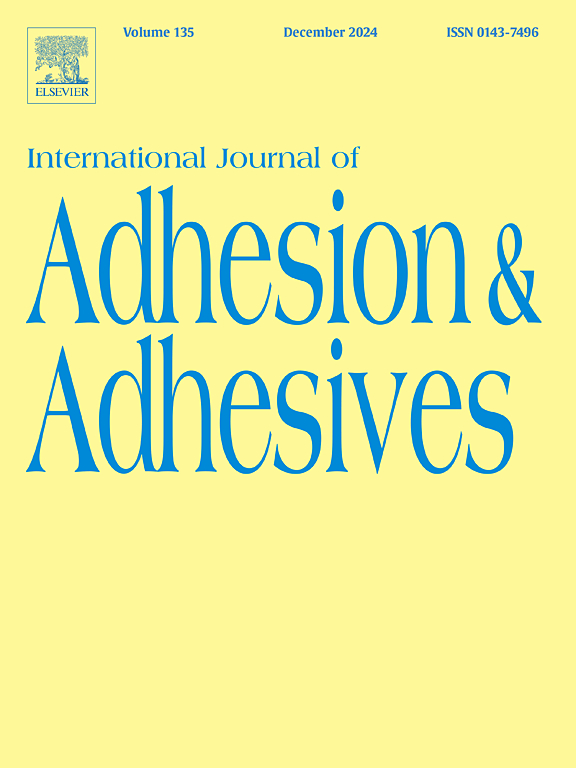A gradient-like thin-walled tube via adhesive bonding for energy absorption
IF 3.2
3区 材料科学
Q2 ENGINEERING, CHEMICAL
International Journal of Adhesion and Adhesives
Pub Date : 2025-03-17
DOI:10.1016/j.ijadhadh.2025.104015
引用次数: 0
Abstract
Gradient wall thickness design is a typical method to enhance the energy absorption efficiency of thin-walled structures. Compared with conventional uniform-thickness thin-walled structures, gradient wall structures are mostly fabricated using electrical discharge wire cutting, which significantly increases their production cost and limits their practical engineering applications. This paper proposes a novel approach to fabricate gradient energy-absorbing structures using adhesive bonded metal plate, which enables rapid fabrication while maintaining energy absorption performance. Mechanical experiments were conducted on adhesive joints to calibrate the constitutive parameters of the adhesive layer and determine the thickness of the adhesive layer and surface treatment conditions. Numerical simulations of the out-of-plane compression and crushing behavior of four adhesive-bonded rectangular tube configurations were carried out to analyze their energy absorption characteristics and structural deformation. Based on the experimentally validated model, the effects of adhesive width ratio and wall thickness of metal plate on the energy absorption for these bonded structures were investigated. Finally, a comparative analysis of the energy absorption performance between adhesive-bonded energy-absorbing structures and traditional gradient-thickness structures was conducted to verify the feasibility and effectiveness of the adhesive-bonded structures. The results indicate that increasing the adhesive width and thickness of metal plate within a certain range can significantly improve energy absorption performance. However, further increases lead to significant degradation in specific energy absorption, along with an elevated risk of adhesive layer failure at the structural ends. In addition, compared to traditional gradient thin-walled structures, the bonded structure shows improvements of 22.50 %, 19.97 %, and 6.37 % in EA, MCF, and SEA, respectively, demonstrating excellent energy absorption performance and great potential for application.
一种通过粘接吸收能量的梯度状薄壁管
梯度壁厚设计是提高薄壁结构吸能效率的一种典型方法。与传统的均厚薄壁结构相比,梯度壁结构大多采用放电线切割制造,这大大增加了其生产成本,限制了其实际工程应用。本文提出了一种利用粘接金属板制造梯度吸能结构的新方法,该方法在保持吸能性能的同时可以实现快速制造。对粘接接头进行力学试验,标定粘接层的本构参数,确定粘接层的厚度和表面处理条件。对四种胶结矩形管的面外压缩破碎行为进行了数值模拟,分析了胶结矩形管的吸能特性和结构变形。在实验验证的模型基础上,研究了金属板的粘接宽度比和壁厚对粘接结构吸能的影响。最后,对比分析了胶接吸能结构与传统梯度厚度结构的吸能性能,验证了胶接吸能结构的可行性和有效性。结果表明,在一定范围内增加金属板的粘接宽度和厚度可以显著提高吸能性能。然而,进一步增加会导致比能吸收的显著下降,同时增加结构端粘接剂层失效的风险。此外,与传统的梯度薄壁结构相比,键合结构在EA、MCF和SEA方面分别提高了22.50%、19.97%和6.37%,表现出优异的吸能性能和巨大的应用潜力。
本文章由计算机程序翻译,如有差异,请以英文原文为准。
求助全文
约1分钟内获得全文
求助全文
来源期刊

International Journal of Adhesion and Adhesives
工程技术-材料科学:综合
CiteScore
6.90
自引率
8.80%
发文量
200
审稿时长
8.3 months
期刊介绍:
The International Journal of Adhesion and Adhesives draws together the many aspects of the science and technology of adhesive materials, from fundamental research and development work to industrial applications. Subject areas covered include: interfacial interactions, surface chemistry, methods of testing, accumulation of test data on physical and mechanical properties, environmental effects, new adhesive materials, sealants, design of bonded joints, and manufacturing technology.
 求助内容:
求助内容: 应助结果提醒方式:
应助结果提醒方式:


